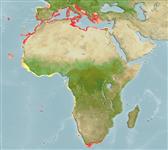Common names from other countries
Environment: milieu / climate zone / depth range / distribution range
Ecologia
; intervalo de profundidade 1 - 110 m (Ref. 85345). Subtropical; 46°N - 37°S, 26°W - 32°E
Eastern Atlantic and the Mediterranean.
Length at first maturity / Tamanho / Peso / Idade
Maturity: Lm ? range ? - ? cm Max length : 60.0 cm WD macho/indeterminado; (Ref. 114251)
Maximum length is in body diameter (Ref. 114251). Infaunal; found on sandy substrates (Refs 106821, 106822). Common on bottoms covered with seagrasses and also occurs on detritic and muddy bottoms (Ref. 106822). Main diet include gastropods and bivalves (Ref. 106164).
Life cycle and mating behavior
Maturidade | Reprodução | Desova | Ovos | Fecundidade | Larvas
Members of the class Asteroidea exhibit both asexual (regeneration and clonal) and sexual (gonochoric) means of reproduction. Life cycle: Embryos hatch into planktonic larvae and later metamorphose into pentamorous juveniles which develop into young sea stars with stubby arms.
MarineSpecies.org. 2050. (Ref. 3477)
Categoria na Lista Vermelha da IUCN (Ref. 130435)
Categoria CITES (Ref. 108899)
Not Evaluated
Not Evaluated
Ameaça para o homem
Harmless
Utilização humana
| FishSource |
Ferramentas
Mais informação
Idade/Tamanho
Crescimento
Comprimento-peso
Comprimento-comprimento
Morfologia
Larvas
Abundância
Fontes da internet
Estimates based on models
Preferred temperature
(Ref.
115969): 14.3 - 21, mean 18.2 (based on 276 cells).
